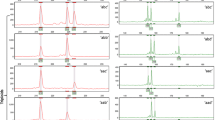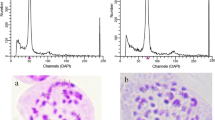Abstract
The induction of unreduced gametes via chromosome doubling is an effective way to produce triploids. During this process, the transmitted parental heterozygosity varies by different origins of unreduced gametes. In this study, a total of 110 allotriploid individuals from two cross combinations who shared only one male parent were obtained by chromosome doubling of megaspore via high temperature treatment in Populus tomentosa. Twenty-six SSR loci, at which the allelic configurations of the female parents ‘MC1’ and ‘MC2’ were heterozygous and different from male parent ‘YX1’, were screened. Among them, five pairs of pericentromeric SSR primers were selected to identify the origins of unreduced female gametes. Our results showed that 30 individuals from 110 allotriploids derived from the first division restitution (FDR), and 80 allotriploids from the second division restitution (SDR) in these two cross combinations. The transmitted parental heterozygosity of unreduced female gametes via FDR were 0.824 and 0.769 in two cross combinations, respectively, which was significantly higher than that of SDR (0.395 and 0.396, respectively). The FDR type unreduced gametes with higher heterozygosity transmitted from parents may be more desirable in triploid breeding. However, no significant difference in transmitted parental heterozygosity was found between the two FDR groups and two SDR groups. Correct elucidation of the origins of unreduced gametes may be conducive to their effective utilization for further sexual hybridization in triploid poplar breeding.


Similar content being viewed by others
References
Arrigo N, Barker MS (2012) Rarely successful polyploids and their legacy in plant genomes. Curr Opin Plant Biol 15(2):140–146
Bakulin VJG (1966) Triploid clone of aspen in the Novosibirsk region forests. Genetika 11:58–68
Barone A, Gebhardt C, Frusciante L (1995) Heterozygosity in 2n gametes of potato evaluated by RFLP markers. Theor Appl Genet 91(1):98–104
Bauer E, Falque M, Walter H, Bauland C, Camisan C, Campo L, Meyer N, Ranc N, Rincent R, Schipprack W, Altmann T, Flament P, Melchinger AE, Menz M, Moreno-González J, Ouzunova M, Revilla P, Charcosset A, Martin OC, Schön C-C (2013) Intraspecific variation of recombination rate in maize. Genome Biol 14(9):R103
Birchler JA, Yao H, Chudalayandi S, Vaiman D, Veitia RA (2010) Heterosis. Plant Cell 22(7):2105–2112
Cervera MT, Storme V, Soto A, Ivens B, Van Montagu M, Rajora OP, Boerjan W (2005) Intraspecific and interspecific genetic and phylogenetic relationships in the genus Populus based on AFLP markers. Theor Appl Genet 111(7):1440–1456
Comai L (2005) The advantages and disadvantages of being polyploid. Nat Rev Genet 6(11):836–846
Cromie GA, Smith GR (2007) Branching out: meiotic recombination and its regulation. Trends Cell Biol 17(9):448–455
De Storme N, Geelen D (2013) Sexual polyploidization in plants—cytological mechanisms and molecular regulation. New Phytol 198(3):670–684
Dong CB, Suo YJ, Kang XY (2014a) Assessment of the genetic composition of triploid hybrid Populus using SSR markers with low recombination frequencies. Can J For Res 44(7):692–699
Dong CB, Mao JF, Suo YJ, Shi L, Wang J, Zhang PD, Kang XY (2014b) A strategy for characterization of persistent heteroduplex DNA in higher plants. Plant J 80(2):282–291
Dong CB, Suo YJ, Wang J, Kang XY (2015) Analysis of transmission of heterozygosity by 2n gametes in Populus (Salicaceae). Tree Genet Genomes 11(1):1–7
Einspahr DW (1984) Production and utilization of triploid hybrid aspen. Iowa State J Res 58(4):401
Fort A, Ryder P, Mckeown PC, Wijnen CL, Aarts MGM, Sulpice R, Spillane C (2016) Disaggregating polyploidy, parental genome dosage and hybridity contributions to heterosis in Arabidopsis thaliana. New Phytol 209(2):590–599
Geng XN, Ren YY, Han ZQ, Du K, Kang XY (2018) Production of hybrid triploids via inducing chromosome doubling of megaspore with high temperature treatment in Leuce poplar. J Beijing For Univ 29(11):22–25
Han ZQ, Geng XN, Du K, Xu CP, Yao PQ, Bai FY, Kang XY (2018) Analysis of genetic composition and transmitted parental heterozygosity of natural 2n gametes in Populus tomentosa based on SSR markers. Planta 247(6):1407–1421
Hansson B, Westerberg L (2002) On the correlation between heterozygosity and fitness in natural populations. Mol Ecol 11(12):2467–2474
Hermsen JGT (1984) Mechanisms and genetic implications of 2n gamete formation. Iowa State J Res 58:421–434
Hulce D, Li X, Snyderleiby T, Johathan Liu CS (2011) GeneMarker® genotyping software: tools to increase the statistical power of DNA fragment analysis. J Biomol Tech JBT 22(Suppl):S35
Hutten RC, Schippers MG, Hermsen JG, Ramanna MS (1994) Comparative performance of FDR and SDR progenies from reciprocal 4x–2x crosses in potato. Theor Appl Genet 89(5):545–550
Kang XY (2002) Cytogenetics and triploid breeding of Populus tomentosa. China Environmental Science Press, Beijing, p 2002
Kang XY (2016) Polyploid induction techniques and breeding strategies in poplar. In: Mason AS (ed) Polyploidy and hybridization for crop improvement. CRC Press, Boca Raton, pp 76–96
Lambing C, Franklin FC, Wang CR (2017) Understanding and manipulating meiotic recombination in plants. Plant Physiol 173(3):1530–1542
Leitch AR, Leitch IJ (2008) Genomic plasticity and the diversity of polyploid plants. Science 320(5875):481–483
Lexer C, Heinze B, Steinkellner H, Kampfer S, Ziegenhagen B, Glössl JJT, Genetics A (2000) Microsatellite analysis of maternal half-sib families of Quercus robur, pedunculate oak: II. Inference of the seed parents from the offspring. Theor Appl Genet 99(1–2):858–865
Li YH, Kang XY (2007) Triploid induction in white poplar by chromosome doubling of megaspore. J Beijing For Univ 29(5):22–25
Li X, Li L, Yan J (2015) Dissecting meiotic recombination based on tetrad analysis by single-microspore sequencing in maize. Nat Commun 6:6648
Li Y, Wang Y, Wang P, Yang J, Kang X (2016) Induction of unreduced megaspores in Eucommia ulmoides by high temperature treatment during megasporogenesis. Euphytica 212(3):515–524
Li D, Tian J, Xue Y, Chen H, Wang J (2019) Triploid production via heat-induced diploidisation of megaspores in Populus pseudo-simonii. Euphytica 215:10
Liao T, Cheng S, Zhu X, Min Y, Kang X (2016) Effects of triploid status on growth, photosynthesis, and leaf area in Populus. Trees 30(4):1137–1147
Liesebach H, Ulrich K, Ewald D (2015) FDR and SDR processes in meiosis and diploid gamete formation in poplars (Populus L.) detected by centromere-associated microsatellite markers. Tree Genet Genomes 11(1):1–10
Lu M, Zhang P, Kang X (2013) Induction of 2n female gametes in Populus adenopoda Maxim by high temperature exposure during female gametophyte development. Breed Sci 63(1):96–103
Mason AS, Pires JC (2015) Unreduced gametes: meiotic mishap or evolutionary mechanism? Trends Genet 31(1):5–10
Modliszewski JL, Wang H, Albright AR, Lewis SM, Bennett AR, Huang J, Ma H, Wang Y, Copenhaver GP (2018) Elevated temperature increases meiotic crossover frequency via the interfering (Type I) pathway in Arabidopsis thaliana. PLoS Genet 14(5):e1007384
Müntzing A (1936) The chromosomes of a giant Populus tremula. Hereditas 21(2–3):383–393
Nilsson-Ehle H (1936) Note regarding the gigas form of Populous tremula found in nature. Hereditas 21(1/2):372–382
Nilsson-Ehle H, Tidn SP (1938) Production of forest trees with increased chromosome number and increased timber yield. Svensk Papp Tidn 2:5
Peloquin SJ, Boiteux LS, Simon PW, Jansky SH (2008) A chromosome-specific estimate of transmission of heterozygosity by 2n gametes in potato. J Hered 99(2):177–181
Ramanna MS, Jacobsen E (2003) Relevance of sexual polyploidization for crop improvement—a review. Euphytica 133(1):3–8
Schuelke M (2000) An economic method for the fluorescent labeling of PCR fragments. Nat Biotechnol 18(2):233–234
Si W, Yuan Y, Huang J, Zhang XH, Zhang YC, Zhang YD, Tian DC, Wang CL, Yang YH, Yang SH (2015) Widely distributed hot and cold spots in meiotic recombination as shown by the sequencing of rice F2 plants. New Phytol 206(4):1491–1502
Soltis PS, Soltis DE (2000) The role of genetic and genomic attributes in the success of polyploids. Proc Nat Acad Sci USA 97(13):7051–7057
Tian MD, Li YJ, Zhang PD, Wang J, Hao JY (2018) Pollen chromosome doubling induced by high temperature exposure to produce hybrid triploids in Populus canescens. Sci Silvae Sin 54(3):39–47
Vining KJ, Pomraning KR, Wilhelm LJ, Priest HD, Pellegrini M, Mockler TC, Freitag M, Strauss SH (2012) Dynamic DNA cytosine methylation in the Populus trichocarpa genome: tissue-level variation and relationship to gene expression. BMC Genom 13(1):1–19
Vorsa N, Rowland LJ (1997) Estimation of 2n megagametophyte heterozygosity in a diploid Blueberry (Vaccinium darrowi Camp) clone using RAPDs. J Hered 88(5):423–426
Wang J, Li DL, Kang XY (2011) Induction of unreduced megaspores with high temperature during megasporogenesis in Populus. Ann For Sci 69(1):59–67
Wang J, Li DL, Shang FN, Kang XY (2017) High temperature-induced production of unreduced pollen and its cytological effects in Populus. Sci Rep 7(1):5281
Wang YX, Copenhaver GP (2018) Meiotic recombination: mixing it up in plants. Annu Rev Plant Biol 69:577–609
Xi XJ, Li D, Xu WT, Guo LQ, Zhang JF, Li BL (2012) 2n egg formation in Populus × euramericana (Dode) Guinier. Tree Genet Genomes 8(6):1237–1245
Xie KD, Wang XP, Biswas MK, Liang WJ, Xu Q, Grosser JW, Guo WW (2014) 2n megagametophyte formed via SDR contributes to tetraploidization in polyembryonic 'Nadorcott' tangor crossed by citrus allotetraploids. Plant Cell Rep 33(10):1641–1650
Yao CL, Pu JW (1998) Timber characteristics and pulp properties of the triploid of Populus tomentosa. J Beijing For Univ 20(5):18–21
Yao CL, Wu DX, Lin HB, Wang R, Wang JH (1992) Studies on timber characterization and paper properties of the hybrid clones of Populus tomentosa. J Beijing For Univ 14(S3):72–77
Yao PQ, Li GH, Long QY, He LG, Kang XY (2016) Male parent identification of triploid rubber trees (Hevea brasiliensis) and the mechanism of 2n gametes formation. Forests 7(12):301
Yao PQ, Li GH, Long QY, He LG, Kang XY (2017) Microsporogenesis and induction of unreduced pollen with high temperatures in rubber tree clone RRIM 600. Forests 8(5):152
Yin TM, Zhang XY, Gunter LE, Li SX, Wullschleger SD, Huang MR, Tuskan GA (2009) Microsatellite primer resource for Populus developed from the mapped sequence scaffolds of the Nisqually-1 genome. New Phytol 181(2):498–503
Zhang JF, Wei ZZ, Li D, Li B (2009) Using SSR markers to study the mechanism of 2n pollen formation in Populus × euramericana (Dode) Guinier and P. × popularis. Ann For Sci 66(5):506
Zhu ZT, Lin HB, Kang XY (1995) Studies on allotriploid breeding of Populus tomentosa B301 clones. Sci Silvae Sin 31(6):499–505
Zhu ZT, Kang XY, Zhang ZY (1998) Studies on selection of natural triploids of Populus tomentosa. Sci Silvae Sin 34(4):22–31
Acknowledgements
The authors would like to thank Professor Jun Wang and Professor Pingdong Zhang, College of Biological Sciences and Technology, Beijing Forestry University for precious suggestion before the submission. And the authors would like to thank the staff of Guanxian nursery in Shandong Province, China for providing the experimental field. We are also grateful to the anonymous reviewers and editors for their constructive comments. This research was financially supported by the National Natural Science Foundation of China (No. 31470667).
Author information
Authors and Affiliations
Contributions
XG and XK conceived and designed the study. XG and ZH conducted experiments. XG, QH and KD analyzed the data. XK supervised experiments. XG, JY and XK wrote and edited manuscripts. All authors read and approved the manuscript.
Corresponding author
Ethics declarations
Conflict of interest
The authors declare that they have no conflict of interest.
Additional information
Publisher's Note
Springer Nature remains neutral with regard to jurisdictional claims in published maps and institutional affiliations.
Electronic supplementary material
Below is the link to the electronic supplementary material.
Rights and permissions
About this article
Cite this article
Geng, X., Han, Z., Yang, J. et al. The different origins of artificially-induced unreduced female gametes and their effect on transmitted parental heterozygosity in Populus. Euphytica 215, 181 (2019). https://doi.org/10.1007/s10681-019-2501-7
Received:
Accepted:
Published:
DOI: https://doi.org/10.1007/s10681-019-2501-7




